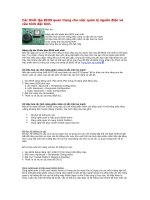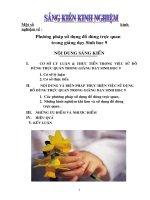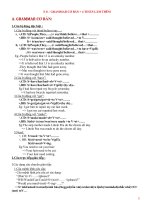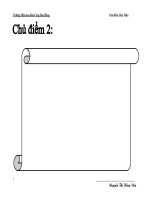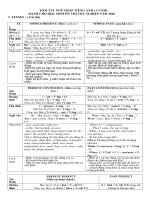12 chủ điểm ngữ pháp quan trọng con cần nắm vững để chuẩn bị cho kỳ thi toefl primary step 2
Bạn đang xem bản rút gọn của tài liệu. Xem và tải ngay bản đầy đủ của tài liệu tại đây (833.19 KB, 7 trang )
Grammar for
toefl primary step 2
1. Be-Verbs (ĐỘNG TỪ TO BE)
Be-verbs are verbs that describe people, places and things. Although they are verbs, be-verbs are different than regular verbs because be-verbs don't show any actions.
Positive form – CẤU TRÚC KHẲNG ĐỊNH
PRESENT – HIỆN TẠI
I am Jane.
You are a student.
He is my friend.
She is pretty.
It is a box.
We are soccer players.
They are in the library.
PAST – QUÁ KHỨ
I was in Italy last year.
You were thirsty.
He was angry.
She was quiet.
It was empty.
We were in Brazil last summer.
They were 12 years old last year.
2
1. Be-Verbs (ĐỘNG TỪ TO BE)
NEGATIVE form – CẤU TRÚC PHỦ ĐỊNH
- We add not to make the negative form with a be-verb.
- We can use contractions to make the negative forms shorter.
is not = isn’t; are not = aren’t; was not = wasn’t; were not = weren't
PRESENT – HIỆN TẠI
I am not Jane.
You are not a student.
He is not my friend.
She is not pretty.
It is not a box.
We are not soccer players.
They are not in the library.
- THêm “Not” sau động từ to be để chuyển sang thể phủ định
- Sử dung cách viết rút gọn:
is not = isn’t; are not = aren’t; was not = wasn’t; were not = weren't
PAST – QUÁ KHỨ
I was not in Italy last year.
You were not thirsty.
He was not angry.
She was not quiet.
It was not empty.
We were not in Brazil last summer.
They were not 12 years old last year.
3
2. A/An/The
✗
✗
✗
Singular means one, so we use “a”
or “an” for a singular countable
noun.
Use a if a singular noun begins
with a consonant, and use an if a
singular noun begins with a vowel.
The vowels are a, e, i, o, and u, and
consonants are all of the letters of
the alphabet besides the vowels.
Examples - Ví dụ
✗
✗
✗
✗
✗
Sử dụng “a” hoặc “an” trước danh từ
đếm được số ít.
Sử dụng “a” nếu danh từ số ít bắt đầu
bằng một phụ âm. Sử dụng “an” nếu
danh từ số ít bắt đầu bằng một
nguyên âm (chú ý là trong cách phát
âm, chứ không phải trong cách viết)
Nguyên âm bao gồm: ”a, e, i, o, u”.
Các chữ cái còn lại trong bảng chữ cái
đều là phụ âm.
a piano; a pen
an apple; an orange
4
2. A/An/The
✗
When you are talking about
something, use the instead of a or
an after you mention it once.
✗
Sử dụng “the” thay cho “a, an” khi nói
đến một danh từ đã được đề cập đến
trước đó trong cuộc trị chuyện.
Examples - Ví dụ:
I have a piano at home. The piano is black.
✗
We use the when the listener
already knows the thing or person
that the speaker is talking about.
✗
Sử dụng “the” khi người nghe đã biết
về vật hoặc người mà người nói muốn
nói đến.
Examples - Ví dụ:
The window is open. Can I close it?
5
2. A/An/The
✗
We use the when we talk about
playing an instrument.
✗
Sử dụng “the” khi nói về việc chơi
nhạc cụ
Examples - Ví dụ:
I play the violin, and my brother plays the guitar.
✗
We use the when we talk about
something that is the only one of its
kind.
✗
Sử dụng “the” để nói về những thứ
chỉ có duy nhất.
Examples - Ví dụ:
the Sun; the Earth; the world; the Internet; the sky; the sea,…
6
3. Some/any
✗
✗
We can use some for both countable
plural nouns and uncountable nouns.
We use some when we are not sure
about the quantity of something.
✗
✗
Sử dụng “some” cho cả danh từ đếm
được và danh từ không đếm được.
Sử dụng “some” khi không xác định
rõ số lượng.
Examples - Ví dụ:
There are some apples in the basket./ I have some money in my pocket.
✗
✗
We can use any for both countable
and uncountable nouns.
Any is used in negative sentences
and questions.
✗
✗
Sử dụng “any” cho cả danh từ đếm
được và danh từ không đếm được.
“any” được sử dụng trong câu phủ
định và nghi vấn.
Examples - Ví dụ:
Q: Are there any eggs in the refrigerator? A: No, there aren't any.
7
